Massachusetts is home to over 250 species of bees several of which are considered large bees. These big buzzers play a vital role as pollinators in the state’s ecosystems. In this article we will explore some of the most common types of large bees found in Massachusetts.
Bumblebees
Bumblebees (Bombus spp.) are perhaps the most recognizable large bee in Massachusetts. These furry insects have round, plump bodies marked with black and yellow stripes. Bumblebees utilize their large size to generate body heat, allowing them to be active in colder temperatures than other bees.
There are over 40 species of bumblebees across North America, many of which inhabit Massachusetts. Common eastern bumblebee species include the rusty patched bumblebee, yellowbanded bumblebee, and brown-belted bumblebee. Bumblebees live in small colonies of up to a few hundred individuals and do not produce honey. However, their fuzzy bodies effectively distribute pollen as they move between flowers, making them excellent pollinators.
Carpenter Bees
Carpenter bees in the genus Xylocopa are robust, shiny bees reaching up to one inch in length They are mostly black but have some yellow markings on the thorax There are two main types of carpenter bees found in Massachusetts
-
Large carpenter bees bore nesting tunnels into dead wood, logs, and wooden structures. They produce large, circular holes during nest construction.
-
Small carpenter bees excavate hollow plant stems, like raspberry canes, to build their nests. These bees have metallic blue-green or black coloring.
Though carpenter bees sometimes damage wood via their nest building activities, they are important pollinators of flowers and food crops. The males are territorial but rarely sting unless handled.
Cuckoo Bees
Cuckoo bees (genus Nomada) are cleptoparasites, meaning they lay their eggs in the nests of other bee species. They do not construct their own nests. Many cuckoo bee species are large-bodied, reaching over 1 cm in length. Their patterns and colors vary widely, with black, yellow, and red bands being common.
Cuckoo bees can resemble wasps due to their variable coloring and pointed abdomens. In Massachusetts, they target the nests of mining bees, plasterer bees, and sweat bees. Once inside, the cuckoo bee larva kills the host egg/larva and consumes the stored food.
Leafcutter Bees
Leafcutter bees in the family Megachilidae get their name from the neat, circular cutouts they make in leaves while building their nests. They use the leaf pieces to line brood cells. These bees have large, robust, black abdomens marked with white stripes. Leafcutter bees range from 0.5 – 1.5 cm in size.
Different leafcutter species utilize various nesting sites, including holes in wood, rock crevices, and underground tunnels. Leafcutter bees are important pollinators of wildflowers, gardens, and food crops. Residential gardens often attract these gentle bees.
Mining Bees
Mining bees in the genus Andrena are compact, fuzzy bees that excavate nesting tunnels in the ground. They frequently nest in aggregations, resulting in dense clusters of mining bee holes. These bees are active in early spring, providing essential pollination services.
Mining bees have black abdomens and heads but are clothed in thick, bright yellow hairs on the thorax. Their stout bodies span 0.5 – 1 cm in size. Though they resemble bumblebees, mining bees do not live in colonies. Each female constructs and provisions her own tunnels.
Massachusetts is rich in native bee diversity, including many types of large bees. These species vary in their nesting habits, foraging behaviors, and physical traits. However, they share the common role of pollinating flowers and crops. Supporting native bee populations through habitat conservation is crucial to maintaining functioning ecosystems across Massachusetts.
Things You Should Know About Bees, Wasps, Hornets, Honey Bees, Carpenter Bees, Ground Bees and Yellowjackets
You can better describe your bee problem to The Bee Hunter of Mass when you call him if you have a picture and description of different kinds of stinging insects, like bees.
Keep in mind that “your bee” or its nest might not look exactly like the picture. Just try to find the bee that looks the most like the picture.
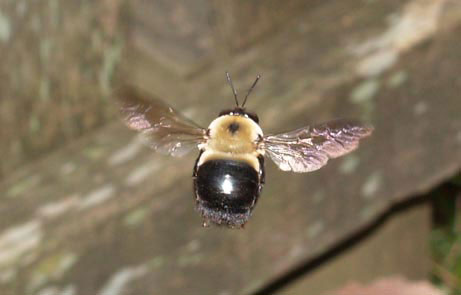
Carpenter bees, unlike other types of bees, love to burrow in wood. They are often found in wooden decks, eaves, and porches tunneling their homes into yours. Even though they aren’t as mean as some other types of bees, they are just as annoying because they damage your home over time.
When carpenter bees drill through wood, they create perfectly round 3/8-inch holes. People often think that the bees are eating the wood or doing other damage to your home’s structure. In fact, they are simply creating tunnels in which to lay their eggs. They may damage a lot of wood, but they won’t destroy a house like termites do. Usually, they won’t damage the structure of your home.
Carpenter bees are different from bald-faced hornets and yellowjackets because they usually stay alone and build their nests near other carpenter bees.
Bald-faced hornets get their name from the white spots on their heads, not because they don’t have any hair. They are the strongest of all bees in Massachusetts and should be avoided if possible. Hornets resemble yellowjackets, but there are more than 20 hornet species. The hornet is more aggressive than most other bees, wasps, and yellowjackets – keep your distance!.
Hornets make their nests in tree branches, under decks, and under the eaves or fascia boards of homes. Unlike yellow jackets, hornets rarely enter homes through gaps in construction. Hornets’ nests look like grayish paper footballs and are made by the hornets themselves.
Hornets have a stinger that can penetrate even thick clothing. When they sting, they leave more venom than do wasps. And unlike some other insects, such as bees, hornets can stings multiple times. When a person irritates a hornet enough, it will send out pheromones to warn its colony that it is being attacked. This will get the whole clan to go after the person who did it.
Hornets are actually wasps of the genus Vespa. (Now you know where that popular scooter got its name!)
Hornets are carnivorous and feed on nectar, sugar-rich plant foods, and overripe fruit. They also eat other bugs, like grasshoppers, locusts, and even honey bees, turning their bodies into mush and feeding it to their young.
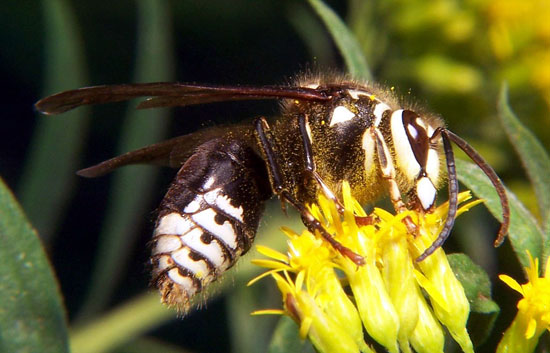
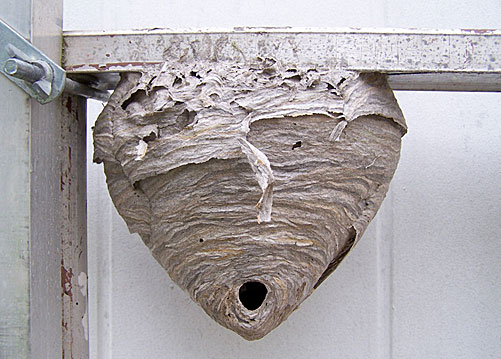
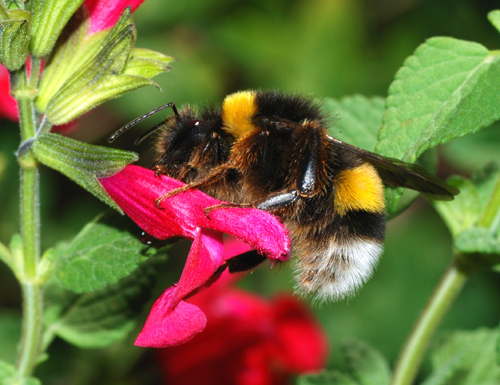
The amount of honey that bumblebees make is much smaller than that made by other bees, even the much more famous honey bee.
Bumblebees love flowers and will often be found inside of them, enjoying the sweet nectar. While they are usually very calm, if they decide to build a nest near your house and you don’t want them there, they may attack to protect their home. Resist the urge to pet them!.
Bumblebees are rarely seen, as they build their nests in loose materials like leaves, grass clippings or mulch. You’ll know a bumblebee has built a nest near your house if you see them coming and going from your yard all the time.
They usually build nests in attics, but also may be found in underground or near sidewalks and patios.
Bumblebees are fuzzy, yellow and black insects that live in colonies. There are 250 species of bumblebees, and they come in many different colors and sizes.
The stinger of a bumblebee is more like that of a hornet than a honey bee. It is not sharp, so it won’t get stuck in your skin, and it can sting more than once.
Bumblebees are more than 30 types of endangered or thought to be extinct. If you want to keep bumblebees happy, you should have flowers and a garden. But if you don’t want them to build a nest under your ladder, a piece of wood, or the hose, you should keep your yard clean.
Wasps are not bees, although they are often confused with bees. While bees have hairy bodies and thin bodies, wasps don’t have hairy bodies or an anchor on their stinger that gets stuck in your skin when they sting. Therefore, wasps can sting multiple times and release powerful venom into your body. Also, unlike bees, wasps do not make honey.
Wasps come in many different colors and sizes. Some wasps are red, yellow, black and blue; some are larger than others. More than 100,000 species of wasps live in the world, and 4,000 species live in the US. Yellowjackets and bald-faced hornets are two of the most common species.
Like bees, wasps eat nectar and fruits; however, they also eat insects and caterpillars. Unlike bees, wasps do not make honey. Some species of wasps do pollinate other flowers and plants, like bees. They are found all over the world except in Polar Regions.
Other than eating other bugs and pests, wasps are also used to keep other bugs and pests away in agricultural settings.
When wasps die, they release pheromones in the air that their comrades in the hive can smell. This is a warning signal for the other wasps, but if you kill them and those pheromones land on your skin, a whole colony of wasps could come after you.
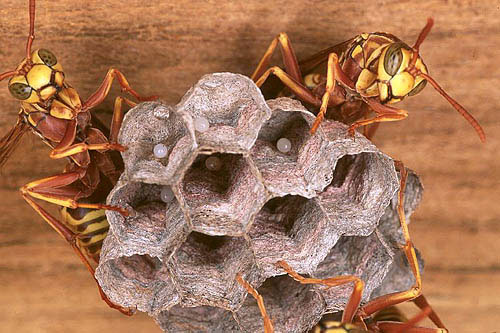
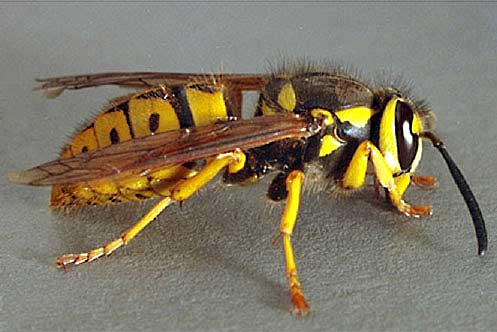
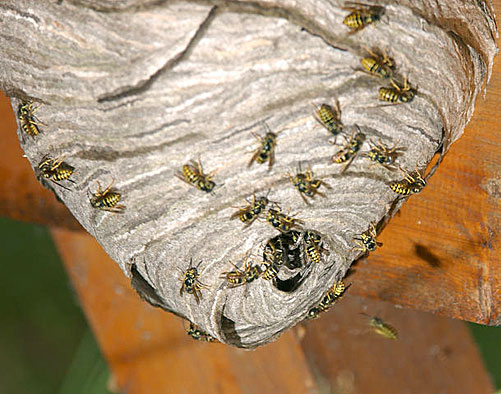
Like hornets, yellowjackets are also wasps. My coworker in Pittsburgh, the Bee Hunter of Pittsburgh, calls them “Steeler” bees, even though they are a little smaller than hornets and are yellow and black.
Yellowjackets are usually seen at picnics, hovering around soda cans or crawling across food. These bees love sweets and meat, but they also eat spiders and other insects.
These bees like to eat people, so they often build their nests in or near homes, especially under decks or near garages. Their nest is football-shaped and looks like a gray paper mache. They may not be able to be seen if you see them flying around your house but can’t find their nest. It’s likely inside YOUR house. If you listen closely you may even hear them – they may sound like leaves rustling. If this happens and you see the hole, DO NOT close it up. If you do, you will accidentally trap the bees inside your home.
If you see bees in or near your home or have been stung by a yellowjacket, hornet, bee, or wasp, please read my Bee Removal Frequently Asked Questions page to learn what to do.
No, those giant wasps in your yard are not ‘murder hornets’ | VERIFY
FAQ
What are the big bees in Massachusetts?
What are the big huge bees called?
Do carpenter bees sting or bite you?
What are the big bees in the Northeast?
Are there worker mason bees in Massachusetts?
There are no worker Mason Bees. Interestingly, Mason Bees are considered the most docile bee in Massachusetts! Farmers and other professionals regularly handle Mason Bees without being stung. They’re often kept on large farms to help with the growing process because they’re highly efficient pollinators.
How do you identify a bumblebee in Massachusetts?
Identifying Characteristics: Fuzzy hair is colored with black and yellow stripes. Large and round-bodied with a pointed head. Bumblebees are the most recognizable bees in Massachusetts! Although they don’t produce honey, they’re essential pollinators for fruit and vegetable crops.
Are there mud wasps in Massachusetts?
Three species of these long, slender wasps can be found in Massachusetts. Black and yellow mud daubers (Sceliphron caementarium) and organ-pipe mud daubers (Trypoxylon politum)—which are black-colored—build mud nests for their young, often on sheltered parts of buildings.
What are the different types of bees?
Leaf-cutter Bee – Megachile X 65 Leucospid Wasp X 66 Long-horned Bee X 67 Mason Bee X 68 Metric Paper Wasp X 69 Miner Bee X 70 Mound Ant X 71 Northern Golden Bumble Bee X 72 Northern Paper Wasp X 73 Norton’s Giant Ichneumon Wasp X 74 Orange-legged Furrow Bee
When should you look for mason bees?
Look for Mason Bees in early spring, when the weather is still chilly. They’re usually one of the first bees to become active after winter. #13. Leaf Cutter Bees
Why are miner bees called bumblebees?
Miner Bees, named for how they dig through dry earth, clay, and even mortar to make their nests, are often confused with Bumblebees because of their similar body shape. They’re different, however, in the way they nest! They’re sometimes called Chimney Bees because of the long tubes they produce while making their nests.
